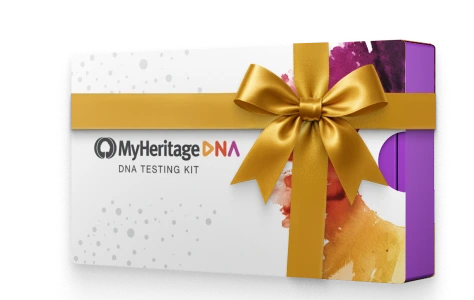In recent years, DNA testing and analysis (also known as genetic testing) has become a mainstay of research in genetics, molecular biology, and other fields in order to understand cellular processes and inheritance of biological traits. Even beyond these applications, DNA testing has also become popular in the context of genealogy and family history research.

Deoxyribonucleic acid, or DNA, is the biological instruction manual of life. Each of an individual’s trillions of cells includes a complete copy of their DNA, and different portions of that “manual” are read in order for cells, tissues, and the body to complete its various processes. In addition, DNA is a biological record of the past. Thus, in instances where historical records have been lost, destroyed, or never created in the first place, DNA testing can aid researchers in overcoming obstacles regarding unknown ancestry and biological relationships.
Through DNA testing, researchers can gain insights into the ethnic origins of their ancestors and connect with genetic cousins. Researchers can leverage a lot of information from the results of DNA tests, such as:
- the types and amounts of DNA they share with a test taker
- the family trees of genetic matches
- documented relationships between multiple genetic matches
- common ancestors shared between genetic relatives
This information can be used to draw conclusions regarding a test taker’s own biological heritage and ancestry. With these research avenues, genealogists can correlate genetic evidence with documentary evidence to break down family history brick walls.
Research your ancestors on MyHeritage
How DNA tests workHow DNA tests work

While early DNA tests used in genealogical research relied on blood samples, the most common modern genetic genealogy tests are cheek swabs or saliva tests. These tests collect cheek cells and white-blood cells in a buffer solution which are then sent to a lab. The DNA is extracted, isolated, amplified, and analyzed to prepare a report of the values at specific DNA locations or markers. Depending on the type of DNA test, anywhere from a handful to hundreds of thousands of markers might be analyzed and tested. When taking a DNA test, an individual should be sure to register their kit with the testing company and carefully follow the provided instructions.
Types of DNA testsTypes of DNA tests
Several types of DNA tests have been developed to analyze different portions of an individual’s DNA. Autosomal DNA, X-DNA, Y-DNA, and mitochondrial DNA exhibit different inheritance patterns and are explored through specialized DNA tests.
Autosomal DNA testsAutosomal DNA tests
The most common types of tests primarily analyze and report information regarding autosomal DNA. These tests analyze hundreds of thousands of autosomal DNA markers across a tester’s genome and generate a report of values at each marker. These reports are compared to curated datasets to estimate a tester’s ethnic origins. They are also compared to databases of other tested customers to identify individuals who share identical values on hundreds to thousands of consecutive DNA markers. Shared identical DNA with these “DNA Matches” is most frequently due to shared recent common ancestry.
Y-DNA, mitochondrial DNA (mtDNA), and X-DNA testsY-DNA, mitochondrial DNA (mtDNA), and X-DNA tests
More specialized tests regarding Y-DNA and mitochondrial DNA are available through some companies. In these tests, anywhere from a handful to several thousand markers are analyzed in order to generate haplogroup designations and lists of genetic cousins who share similar Y-DNA or mitochondrial DNA signatures.
Males inherit Y-DNA from direct patrilineal (paternal) ancestors, and all individuals inherit mitochondrial DNA (mtDNA) from their direct matrilineal (maternal) ancestors. Y-DNA and mtDNA testing can help researchers explore questions regarding their direct line ancestors.
Autosomal and X-DNA vs. Y-DNA and mtDNA testsAutosomal and X-DNA vs. Y-DNA and mtDNA tests
Autosomal DNA is inherited from many ancestors across many lines of an individual’s ancestry. However, the amount of DNA inherited from a specific ancestor decreases with each more distant generation of descent. Eventually, some descendants of an ancestor may not have inherited any DNA at all from that individual. As a result, autosomal DNA testing is most effective for exploring research questions within the last 6-8 generations of a tester’s family tree.
X-DNA information, which is sometimes reported as part of autosomal DNA tests, can narrow a tester’s search for the ancestral source of shared DNA with a genetic cousin to specific branches of their family tree and their match’s family tree. While Y-DNA and mtDNA tests provide specificity for historic research questions, autosomal and X-DNA provide more breadth for recent research questions.

DNA testing can help researchers explore genealogical questions relating to biological origins and biological relationships in cases of:
- Adoption
- Unknown parentage
- Misattributed parentage
- Lack of records
- Difficult-to-trace ancestry
Testers may discover surprises in their own family tree and resolution of their most stubborn brick-wall challenges by incorporating DNA testing into their genealogical research.
See alsoSee also
Explore more about DNA testsExplore more about DNA tests
- MyHeritage DNA Test Kit
- How to Find Unknown Family with MyHeritage DNA at MyHeritage Knowledge Base
- The science behind MyHeritage DNA testing at MyHeritage Knowledge Base
- 5 Traits You Never Knew Were Hereditary at MyHeritage Blog
- Autosomal DNA Analysis Confirms Identity of Living Descendant of Sitting Bull at MyHeritage Blog

